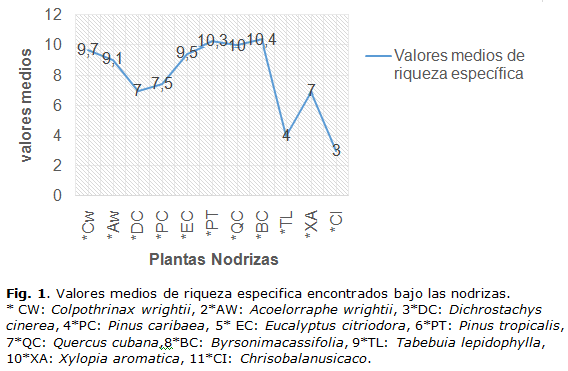Evidences of facilitation between plants in the quarzitic sands of San Ubaldo
Main Article Content
Abstract
The investigation took place in an area of 2 km² toward the interior of a dry plain of quarzitic sands on the Floristic Managed Reservation San Ubaldo-Sabanalamar; to carry out the study they were located six parallel, lineal transepts of 100 m of long for 1 of wide. Was carried out a general list of the flora; in accordance with the habit, the species were determined as nurses and is estimated their covering according with the transept line method, besides calculating the distance in the land that separate each one them, are identified the species that are under the canopy of nurses and also those that occupy the empty spaces among them, counting the number of individuals for species to calculate the frequency and abundance of them, which are the plants that better recruit other species (best nurses), as well as a group of interesting associations for future studies. A floristic inventory was obtained ,was visible that the specific richness of species under the nurses was significantly superior to the empty spaces; through other analyses, was demonstrated that the species that cohabit there were not related phylogenetically, those results prove that relationships of facilitation exist between plants as well as the importance of the nurse effect in typical interactions in extreme environments, information that could be vital for restoring those degraded ecosystems with proven difficulties for the conservation ex situ of their species.
Downloads
Article Details
References
BERTNESS, M. D. y CALLAWAY, R. M. Positive interactions in communities. Trends in Ecology & Evolutión [En línea]. 1994, mayo, 9(5), 191-193. ISSN: 0169-5347. Disponible en: http://www.sciencedirect.com/science/article/pii/0169534794900884
BORHIDI A. L. Phytogeography and vegetation ecology of Cuba. Budapest, Hungary: Akademia Kiado, 1991. ISBN 9630552957
BROOKER, R. W. y CALLAGHAN, T. V. The balance between positive and negative plant interactions and its relationship to environmental gradients: A Model. Oikos [En línea] .1998, febrero, 81(1). 196-207. doi: 10.2307/3546481. Disponible en: http://www.jstor.org/stable/3546481?seq=1#page_scan_tab_contents
BRUNO, J. F, STACHOWICZ, J. J. y BERTNESS, M. D. Inclusion of facilitation into ecological theory. Trends in Ecology & Evolutión [En línea]. 2003, marzo, 18(3), 119-125. ISSN: 0169-5347. Disponible en: http://www.sciencedirect.com/science/article/pii/S0169534702000459
CALLAWAY, R. M. Positive interactions and interdependence in plant communities. Montana: Springer Netherlands, 2007. ISBN: 978-1-4020-6223-0
CANFIELD R. H., Application of the line intercepts method in sampling range vegetation. Journal of Forestry [En línea]. 1941, abril, 39 (4). 388-394. ISSN 0022-1201 .Disponible en: http://www.ingentaconnect.com/content/saf/jof/1941/00000039/00000004/art00012
FLORES, J. y JURADO, E. Are nurse-protégé interactions more common among plantsfrom arid environments? Journal of Vegetation Science [En línea]. 2003, diciembre, 14(6). 911-916. ISSN1654-1103. Disponible en: http://www.bioone.org/doi/abs/10.1658/1100-9233%282003%29014[0911:ANIMCA]2.0.CO%3B2
KELLMAN, M. Soil enrichment by Netropical savanna trees, Journal of Ecology [En línea]. Julio, 1979, 67(2). 565-577. Disponible en: http://www.jstor.org/stable/2259112#?seq=1#page_scan_tab_contents
NOVO R, LUÍS M., URQUIOLA A. y VEGA E.: Análisis paleogeográfico de las Llanuras arenosas de Pinar del Río. Instituto Superior Pedagógico de Pinar del Río: Departamento de Geografía-Centro de Documentación., 1984.
OVIEDO PRIETO R., FAIFE CABRERA M., NOA MONZÓN A., ARROYO J., VALIENTE-BANUET A. Facilitation allows plant coexistence in Cuban serpentine soils. Plant Biology, 2014, Julio, 16(4). 711–716. ISSN 1435-8603. Disponible en: http://onlinelibrary.wiley.com/doi/10.1111/plb.12116/full
PUGNAIRE, F. I. & LUQUE, M. T. Changes in plant interactions along a gradient of environmental stress./Oikos, 2001, abril, 93(1). 42-49. DOI: 10.1034/j.1600-0706.2001.930104.x. Disponible en: http://onlinelibrary.wiley.com/doi/10.1034/j.1600-0706.2001.930104.x/full
RAMÍREZ CONTRERAS, A. y RODRÍGUEZ TREJO, D. A. Plantas nodriza en la reforestación con PinushartwegiiLindl. Revista Chapingo ,2009, 15 (1). 43-48. ISSN: 0186-3231
RICARDO NÁPOLES N.E., et al. Tipos y características de las formaciones vegetales de Cuba. Acta Botánica Cubana [En línea]. 2009. Disponible en: http://repositorio.geotech.cu/xmlui/handle/1234/660
STEVENS, P.F. Angiosperm Phylogeny Website. Version13. [En línea]. Missouri Botanical Garden: University of Missouri, St Louis. [consultado 19 febrero 2013] Disponible en: http://www.mobot.org/MOBOT/research/APweb/
TIRADO R. & PUGNAIRE F.I. Community estructure and positive interactions in constraining environments. Oikos [En línea]. 2005, diciembre, 111(3). 437-444. DOI: 10.1111/j.1600-0706.2005.14094.x. Disponible en: http://onlinelibrary.wiley.com/doi/10.1111/j.1600-0706.2005.14094.x/full
VALIENTE-BANUET A., et al. Modern Quaternary plant lineages promote diversity through facilitation of ancient Tertiary lineages. Proceedings of the National Academy of Sciences USA [En línea]. 2006, 103(45). 16812–16817. SSN 1091-6490. DOIi: 10.1073/pnas.0604933103. Disponible en: http://www.pnas.org/content/103/45/16812.short
VALIENTE-BANUET A. y VERDÚ M. Facilitation can increase the phylogenetic diversity of plant communities. Ecology Letters [En línea]. 2007, noviembre, 10(11). 1029–1036. DOI: 10.1111/j.1461-0248.2007.01100.x. Disponible en: http://onlinelibrary.wiley.com/doi/10.1111/j.1461-0248.2007.01100.x/full
VERDU M., VALIENTE-BANUET A. The nested assembly of plant facilitation networks prevents species extinctions. The American Naturalist [En línea]. 2008, diciembre, 172(6). 751–760. DOI: 10.1086/593003. Disponible en: http://www.journals.uchicago.edu/doi/abs/10.1086/593003
WEBB C.O., ACKERLY D.D. y KEMBEL S.W. Phylocom: software for the analysis of phylogenetic community structure and character evolution. Bioinformatics Applications Note [En línea]. 2008, agosto, 24(18). 2098–2100. doi:10.1093/bioinformatics/btn358. Disponible en: http://phylodiversity.net/cwebb/pubs/webb2008_phylocom.pdf
WIKSTROM N., SAVOLAINEN V., CHASE M.W. Evolution of the angiosperms: calibrating the family tree. The Royal Society [En línea]. 2001, noviembre, 268(1482). 2211–2220. DOI: 10.1098/rspb.2001.1782. Disponible en: http://rspb.royalsocietypublishing.org/content/royprsb/268/1482/2211.full.pdf


